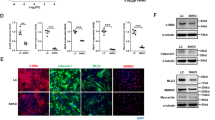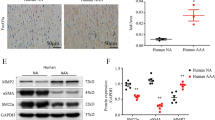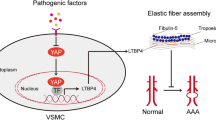Abstract
Abdominal aortic aneurysm (AAA) has been associated with the dysfunction of vascular smooth muscle cells (VSMCs) and extracellular matrix (ECM) remodelling. Runt-related transcription factor 3 (RUNX3) has been reported to be up-regulated in aneurysmal aorta samples compared with normal aorta. However, its function in VSMCs and the mechanism of function remains unknown. Therefore, our study aimed to investigate the role of RUNX3 in ECM remodelling and VSMC function, and further explore the underlying mechanism. Our results verified that RUNX3 was increased in aortic samples of AAA compared with healthy controls. Overexpression vectors of RUNX3 (ov-RUNX3) and siRNA of RUNX3 (si-RUNX3) were transfected into Human aortic smooth muscle cells (HAoSMCs). The results indicated that ov-RUNX3 promoted cell proliferation, migration, and MMP-2/3/9 secretion, and suppressed TIMP-1, collagen I/III, SM22, MYH11 and CNN1 expression in HAoSMCs. The silencing of RUNX3 has the opposite effect. Furthermore, we found that RUNX3 targets TGF-β1 and suppressed its transcription. The silencing of TGF-β1 increased cell proliferation, migration and MMP-2/3/9 expression, and inhibited TIMP-1, Collagen I/III, SM22, MYH11 and CNN1 expression. In addition, TGF-β1 reversed the effect of RUNX3 overexpression on HAoSMCs. Hence, our study indicated that RUNX3 promotes cell proliferation, migration, and ECM remodelling through suppressing TGF-β1.






Similar content being viewed by others

Data availability
The analyzed data sets generated during the study are available from the corresponding author on reasonable request.
Abbreviations
- AAA:
-
Abdominal aortic aneurysm
- ECM:
-
Extracellular matrix
- VSMCs:
-
Vascular smooth muscle cells
- MMPs:
-
Matrix metalloproteinases
- TIMP-1:
-
Tissue inhibitor of metalloproteinases 1
- RUNX:
-
Runt related transcription factors
- HAoSMCs:
-
Human aortic smooth muscle cells
- OV-RUNX3:
-
Overexpression vectors of RUNX3
- si-RUNX3:
-
RUNX3 siRNA oligo duplex
References
Angelov SN, Hu JH, Wei H, Airhart N, Shi M, Dichek DA (2017) TGF-β (transforming growth factor-β) signaling protects the thoracic and abdominal aorta from angiotensin II-induced pathology by distinct mechanisms. Arterioscler Thromb Vasc Biol 37:2102–2113
Chen C, Wang Y, Cao Y, Wang Q, Anwaier G, Zhang Q, Qi R (2020) Mechanisms underlying the inhibitory effects of probucol on elastase-induced abdominal aortic aneurysm in mice. Br J Pharmacol 177:204–216
Chuang LS, Ito K, Ito Y (2013) RUNX family: regulation and diversification of roles through interacting proteins. Int J Cancer 132:1260–1271
Date Y, Ito K (2020) Oncogenic RUNX3: a link between p53 deficiency and MYC dysregulation. Mol Cells 43:176–181
Deguchi JO, Huang H, Libby P, Aikawa E, Whittaker P, Sylvan J, Lee RT, Aikawa M (2009) Genetically engineered resistance for MMP collagenases promotes abdominal aortic aneurysm formation in mice infused with angiotensin II. Lab Invest 89:315–326
Doyle AJ, Redmond EM, Gillespie DL, Knight PA, Cullen JP, Cahill PA, Morrow DJ (2015) Differential expression of Hedgehog/Notch and transforming growth factor-β in human abdominal aortic aneurysms. J Vasc Surg 62:464–470
Dubis J, Litwin M, Michalowska D, Zuk N, Szczepanska-Buda A, Grendziak R, Baczynska D, Barc P, Witkiewicz W (2016) Elevated expression of runt-related transcription factors in human abdominal aortic aneurysm. J Biol Regul Homeost Agents 30:497–504
Golledge J (2019) Abdominal aortic aneurysm: update on pathogenesis and medical treatments. Nat Rev Cardiol 16:225–242
Guirguis-Blake JM, Beil TL, Senger CA, Coppola EL (2019) Primary care screening for abdominal aortic aneurysm: updated evidence report and systematic review for the US preventive services task force. JAMA 322:2219–2238
Guo C, Yao F, Wu K, Yang L, Zhang X, Ding J (2010) Chromatin immunoprecipitation and association study revealed a possible role of Runt-related transcription factor 3 in the ulcerative colitis of Chinese population. Clin Immunol 135:483–489
Hadi T, Boytard L, Silvestro M, Alebrahim D, Jacob S, Feinstein J, Barone K, Spiro W, Hutchison S, Simon R, Rateri D, Pinet F, Fenyo D, Adelman M, Moore KJ, Eltzschig HK, Daugherty A, Ramkhelawon B (2018) Macrophage-derived netrin-1 promotes abdominal aortic aneurysm formation by activating MMP3 in vascular smooth muscle cells. Nat Commun 9:5022
He X, Wang S, Li M, Zhong L, Zheng H, Sun Y, Lai Y, Chen X, Wei G, Si X, Han Y, Huang S, Li X, Liao W, Liao Y, Bin J (2019) Long noncoding RNA GAS5 induces abdominal aortic aneurysm formation by promoting smooth muscle apoptosis. Theranostics 9:5558–5576
Hu W, Wang Z, Li Q, Wang J, Li L, Jiang G (2019) Upregulation of lincRNA-p21 in thoracic aortic aneurysms is involved in the regulation of proliferation and apoptosis of vascular smooth muscle cells by activating TGF-β1 signaling pathway. J Cell Biochem 120:4113–4120
Huang Y, Shen Z, Chen Q, Huang P, Zhang H, Du S, Geng B, Zhang C, Li K, Tang C, Du J, Jin H (2016) Endogenous sulfur dioxide alleviates collagen remodeling via inhibiting TGF-β/Smad pathway in vascular smooth muscle cells. Sci Rep 6:19503
Jones JA, Spinale FG, Ikonomidis JS (2009) Transforming growth factor-beta signaling in thoracic aortic aneurysm development: a paradox in pathogenesis. J Vasc Res 46:119–137
Kim HJ, Kim MY, Jin H, Kim HJ, Kang SS, Kim HJ, Lee JH, Chang KC, Hwang JY, Yabe-Nishimura C, Kim JH, Seo HG (2009) Peroxisome proliferator-activated receptor delta regulates extracellular matrix and apoptosis of vascular smooth muscle cells through the activation of transforming growth factor-{beta}1/Smad3. Circ Res 105:16–24
Kim BR, Kang MH, Kim JL, Na YJ, Park SH, Lee SI, Kang S, Joung SY, Lee SY, Lee DH, Min BW, Oh SC (2016) RUNX3 inhibits the metastasis and angiogenesis of colorectal cancer. Oncol Rep 36:2601–2608
Klaus V, Tanios-Schmies F, Reeps C, Trenner M, Matevossian E, Eckstein HH, Pelisek J (2017) Association of matrix metalloproteinase levels with collagen degradation in the context of abdominal aortic aneurysm. Eur J Vasc Endovasc Surg 53:549–558
Lee CW, Chuang LS, Kimura S, Lai SK, Ong CW, Yan B, Salto-Tellez M, Choolani M, Ito Y (2011) RUNX3 functions as an oncogene in ovarian cancer. Gynecol Oncol 122:410–417
Lenk GM, Tromp G, Weinsheimer S, Gatalica Z, Berguer R, Kuivaniemi H (2007) Whole genome expression profiling reveals a significant role for immune function in human abdominal aortic aneurysms. BMC Genomics 8:237
Li FF, Shang XK, Du XL, Chen S (2018) Rapamycin treatment attenuates angiotensin II -induced abdominal aortic aneurysm formation via VSMC phenotypic modulation and down-regulation of ERK1/2 activity. Curr Med Sci 38:93–100
Li X, Zhong M, Wang J, Wang L, Lin Z, Cao Z, Huang Z, Zhang F, Li Y, Liu M, Ma X (2019) miR-301a promotes lung tumorigenesis by suppressing Runx3. Mol Cancer 18:99
Li Z, Zhao Z, Cai Z, Sun Y, Li L, Yao F, Yang L, Zhou Y, Zhu H, Fu Y, Wang L, Fang W, Chen Y, Kong W (2020) Runx2 (runt-related transcription factor 2)-mediated microcalcification is a novel pathological characteristic and potential mediator of abdominal aortic aneurysm. Arterioscler Thromb Vasc Biol 40:1352–1369
Liu Y, Li B, Wang Y, Wang D, Zou J, Ke X, Hao Y (2016) Knockdown of RUNX3 inhibits hypoxia-induced endothelial-to-mesenchymal transition of human cardiac microvascular endothelial cells. Xi Bao Yu Fen Zi Mian Yi Xue Za Zhi 32:1627–1631
Liu Y, Zou J, Li B, Wang Y, Wang D, Hao Y, Ke X, Li X (2017) RUNX3 modulates hypoxia-induced endothelial-to-mesenchymal transition of human cardiac microvascular endothelial cells. Int J Mol Med 40:65–74
Lotem J, Levanon D, Negreanu V, Bauer O, Hantisteanu S, Dicken J, Groner Y (2017) Runx3 in immunity, inflammation and cancer. Adv Exp Med Biol 962:369–393
Milner JJ, Toma C, Yu B, Zhang K, Omilusik K, Phan AT, Wang D, Getzler AJ, Nguyen T, Crotty S, Wang W, Pipkin ME, Goldrath AW (2017) Runx3 programs CD8(+) T cell residency in non-lymphoid tissues and tumours. Nature 552:253–257
Pardali E, Goumans MJ, ten Dijke P (2010) Signaling by members of the TGF-beta family in vascular morphogenesis and disease. Trends Cell Biol 20:556–567
Rabkin SW (2014) Differential expression of MMP-2, MMP-9 and TIMP proteins in thoracic aortic aneurysm - comparison with and without bicuspid aortic valve: a meta-analysis. Vasa 43:433–442
Rabkin SW (2017) The role matrix metalloproteinases in the production of aortic aneurysm. Prog Mol Biol Transl Sci 147:239–265
Rahmanian N, Tarighi P, Gharghabi M, Torshabi M, Tarfiei GA, Mohammadi Farsani T, Ostad SN, Ghahremani MH (2017) Truncated forms of RUNX3 unlike full length protein alter cell proliferation in a TGF-β context dependent manner. Iran J Pharm Res 16:1194–1203
Song H, Xu T, Feng X, Lai Y, Yang Y, Zheng H, He X, Wei G, Liao W, Liao Y (2020) Itaconate prevents abdominal aortic aneurysm formation through inhibiting inflammation via activation of Nrf2. EBioMedicine 57:102832
Spin JM, Hsu M, Azuma J, Tedesco MM, Deng A, Dyer JS, Maegdefessel L, Dalman RL, Tsao PS (2011) Transcriptional profiling and network analysis of the murine angiotensin II-induced abdominal aortic aneurysm. Physiol Genomics 43:993–1003
Sun J, Li B, Jia Z, Zhang A, Wang G, Chen Z, Shang Z, Zhang C, Cui J, Yang W (2018) RUNX3 inhibits glioma survival and invasion via suppression of the β-catenin/TCF-4 signaling pathway. J Neurooncol 140:15–26
Van Doren SR (2015) Matrix metalloproteinase interactions with collagen and elastin. Matrix Biol 44–46:224–231
Wagenseil JE, Mecham RP (2009) Vascular extracellular matrix and arterial mechanics. Physiol Rev 89:957–989
Wang YD, Liu ZJ, Ren J, Xiang MX (2018) Pharmacological therapy of abdominal aortic aneurysm: an update. Curr Vasc Pharmacol 16:114–124
Weersma RK, Zhou L, Nolte IM, van der Steege G, van Dullemen HM, Oosterom E, Bok L, Peppelenbosch MP, Faber KN, Kleibeuker JH, Dijkstra G (2008) Runt-related transcription factor 3 is associated with ulcerative colitis and shows epistasis with solute carrier family 22, members 4 and 5. Inflamm Bowel Dis 14:1615–1622
Xu X, Zhang F, Lu Y, Yu S, Sun W, Sun S, Cheng J, Ma J, Zhang M, Zhang C, Zhang Y, Zhang K (2019) Silencing of NONO inhibits abdominal aortic aneurysm in apolipoprotein E-knockout mice via collagen deposition and inflammatory inhibition. J Cell Mol Med 23:7449–7461
Xue J, Wu X, Qu M, Guo F, Han L, Sun G, Yuan Z, Fan S, Li T (2020) RUNX3 inhibits the invasion and metastasis of human colon cancer HT-29 cells by upregulating MMP-2/9. Evid Based Complement Alternat Med 2020:5978131
Xue M, Li G, Li D, Wang Z, Mi L, Da J, Jin X (2019) Up-regulated MCPIP1 in abdominal aortic aneurysm is associated with vascular smooth muscle cell apoptosis and MMPs production. Biosci Rep. https://doi.org/10.1042/BSR20191252
Zhang Y, Wang S, Lai Q, Fang Y, Wu C, Liu Y, Li Q, Wang X, Gu C, Chen J, Cai J, Li A, Liu S (2020) Cancer-associated fibroblasts-derived exosomal miR-17-5p promotes colorectal cancer aggressive phenotype by initiating a RUNX3/MYC/TGF-β1 positive feedback loop. Cancer Lett 491:22–35
Funding
None.
Author information
Authors and Affiliations
Contributions
ZZ and HZ: conception, design and analysis of data, performed the data analyses, and wrote the manuscript. XZ: contributed to the conception of the study. XW: contributed significantly to analysis and manuscript preparation. All authors contributed to interpretation of date and review of the manuscript, and approved this manuscript for submission.
Corresponding author
Ethics declarations
Conflict of interest
The authors declare that they have no conflict of interest.
Additional information
Publisher's Note
Springer Nature remains neutral with regard to jurisdictional claims in published maps and institutional affiliations.
Rights and permissions
About this article
Cite this article
Zhou, Z., Zhou, H., Zou, X. et al. RUNX3 is up-regulated in abdominal aortic aneurysm and regulates the function of vascular smooth muscle cells by regulating TGF-β1. J Mol Histol 53, 1–11 (2022). https://doi.org/10.1007/s10735-021-10035-9
Received:
Accepted:
Published:
Issue Date:
DOI: https://doi.org/10.1007/s10735-021-10035-9



